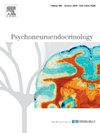每日皮质醇与反刍:性别差异的检验
IF 3.6
2区 医学
Q2 ENDOCRINOLOGY & METABOLISM
引用次数: 0
摘要
来自实验室压力源研究的新证据表明,反刍倾向与下丘脑-垂体-肾上腺(HPA)轴的长期激活以及其最终产物皮质醇水平升高之间的关系存在性别/性别差异。然而,关于反刍和昼夜皮质醇的研究,特别是与HPA活动和性别/性别差异的关系,是有限的。本研究的主要目的是将实验室研究结果扩展到自然环境中。日皮质醇斜率(DCS),全天皮质醇的典型下降的量度,进行了检查。该研究还调查了反刍-皮质醇的关联是否因反刍类型和性别而异:压力集中的反刍,包括对过去或现在的压力源的思考,以及沉思反刍,侧重于对悲伤情绪的评估反应。样本包括116名大学年龄的成年人(63名女性,53名男性),他们在五天的时间里每天提供六份唾液皮质醇样本。分析显示,男性和女性在压力集中的反刍和日常皮质醇之间的联系有所不同。具有较高压力源反刍水平的女性表现出较平坦的皮质醇日斜率,而在男性中观察到相反的模式。在沉思反刍中没有观察到这种联系。两项反刍测量均与日皮质醇水平无直接关系。这些发现表明,女性在日常生活中从事高水平的压力集中反刍会改变每天的皮质醇水平,而男性则不会。本文章由计算机程序翻译,如有差异,请以英文原文为准。
Diurnal cortisol and rumination: Examining gender differences
Emerging evidence from laboratory stressor studies suggests gender/sex differences in the relationship between the tendency to ruminate and prolonged activation of the hypothalamic-pituitary-adrenal (HPA) axis, as well as elevated levels of its end-product, cortisol. However, research on rumination and diurnal cortisol, particularly in relation to HPA activity and gender/sex differences, is limited. The primary aim of the present study was to extend laboratory findings to a naturalistic setting. Diurnal cortisol slope (DCS), a measure of typical decline in cortisol throughout the day, was examined. The study also examined whether rumination-cortisol associations differed by rumination type and gender/sex: stressor-focused rumination, which involves dwelling on past or current stressors, and brooding rumination, which focuses on evaluative reactions to sad emotions. The sample included 116 college-aged adults (63 women, 53 men) who provided six salivary cortisol samples throughout the day over five days. Analyses revealed that men and women differed in their associations between stressor-focused rumination and diurnal cortisol. Women with higher levels of stressor-focused rumination displayed flatter diurnal cortisol slopes, whereas the opposite pattern was observed in men. No such associations were observed for brooding rumination. Neither rumination measure was directly associated with diurnal cortisol. These findings suggest that women who engage in higher levels of stressor-focused rumination display altered diurnal cortisol in daily life, but not men.
求助全文
通过发布文献求助,成功后即可免费获取论文全文。
去求助
来源期刊

Psychoneuroendocrinology
医学-精神病学
CiteScore
7.40
自引率
8.10%
发文量
268
审稿时长
66 days
期刊介绍:
Psychoneuroendocrinology publishes papers dealing with the interrelated disciplines of psychology, neurobiology, endocrinology, immunology, neurology, and psychiatry, with an emphasis on multidisciplinary studies aiming at integrating these disciplines in terms of either basic research or clinical implications. One of the main goals is to understand how a variety of psychobiological factors interact in the expression of the stress response as it relates to the development and/or maintenance of neuropsychiatric illnesses.
 求助内容:
求助内容: 应助结果提醒方式:
应助结果提醒方式:


